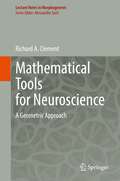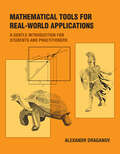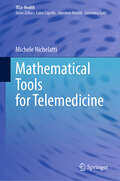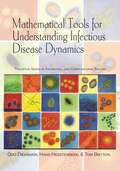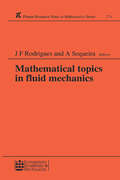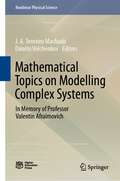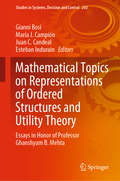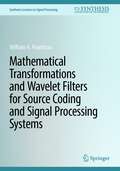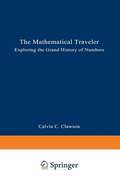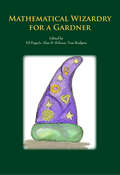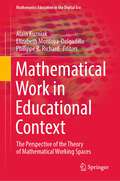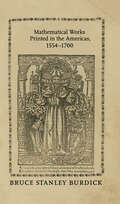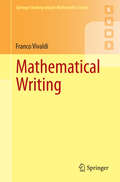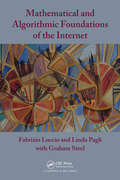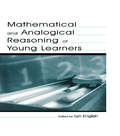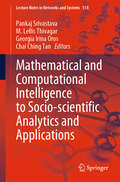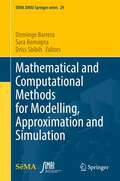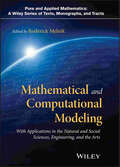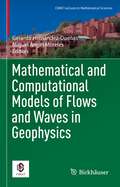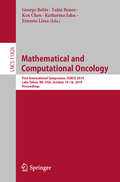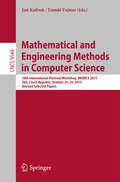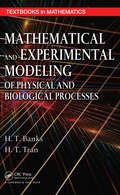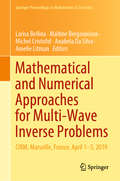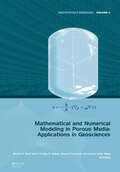- Table View
- List View
Mathematical Tools for Neuroscience: A Geometric Approach (Lecture Notes in Morphogenesis)
by Richard A. ClementThis book provides a brief but accessible introduction to a set of related, mathematical ideas that have proved useful in understanding the brain and behaviour. If you record the eye movements of a group of people watching a riverside scene then some will look at the river, some will look at the barge by the side of the river, some will look at the people on the bridge, and so on, but if a duck takes off then everybody will look at it. How come the brain is so adept at processing such biological objects? In this book it is shown that brains are especially suited to exploiting the geometric properties of such objects. Central to the geometric approach is the concept of a manifold, which extends the idea of a surface to many dimensions. The manifold can be specified by collections of n-dimensional data points or by the paths of a system through state space. Just as tangent planes can be used to analyse the local linear behaviour of points on a surface, so the extension to tangent spaces can be used to investigate the local linear behaviour of manifolds. The majority of the geometric techniques introduced are all about how to do things with tangent spaces.Examples of the geometric approach to neuroscience include the analysis of colour and spatial vision measurements and the control of eye and arm movements. Additional examples are used to extend the applications of the approach and to show that it leads to new techniques for investigating neural systems. An advantage of following a geometric approach is that it is often possible to illustrate the concepts visually and all the descriptions of the examples are complemented by comprehensively captioned diagrams.The book is intended for a reader with an interest in neuroscience who may have been introduced to calculus in the past but is not aware of the many insights obtained by a geometric approach to the brain. Appendices contain brief reviews of the required background knowledge in neuroscience and calculus.
Mathematical Tools for Real-World Applications: A Gentle Introduction for Students and Practitioners
by Alexandr DraganovTechniques for applying mathematical concepts in the real world: six rarely taught but crucial tools for analysis, research, and problem-solving.Many young graduates leave school with a solid knowledge of mathematical concepts but struggle to apply these concepts in practice. Real scientific and engineering problems are different from those found in textbooks: they are messier, take longer to solve, and standard solution recipes might not apply. This book fills the gap between what is taught in the typical college curriculum and what a practicing engineer or scientist needs to know. It presents six powerful tools for analysis, research, and problem-solving in the real world: dimensional analysis, limiting cases, symmetry, scaling, making order of magnitude estimates, and the method of successive approximations. The book does not focus on formulaic manipulations of equations, but emphasizes analysis and explores connections between the equations and the application. Each chapter introduces a set of ideas and techniques and then shows how these techniques apply to a series of problems. (Knowledge of algebra and trigonometry, but not calculus, is required.) The final two chapters tie all six techniques together and apply them to two real-world problems: computing the probability of a rare, catastrophic event, and tracking a satellite with a GPS receiver. Readers will learn how to analyze, dissect, and gain insight into the results by using all the techniques presented in earlier chapters—and discover how analysis tools work on problems not concocted for a textbook. The appendix provides solutions to many of the problems found throughout the book. Alexandr Draganov was born and raised in Kyiv, Ukraine; in light of the current war in Ukraine he will donate 100% of his royalties for the first year to support medical and humanitarian efforts there.
Mathematical Tools for Telemedicine (TELe-Health)
by Michele NichelattiThis book is intended for professionals who must deal with telemedicine having little or no knowledge of matrix algebra and matrix calculus, and little or no knowledge of higher mathematics with special reference to differential equations: no other books cover these topics starting from scratch. It would therefore fill the gap existing between very simple and elementary textbooks and much more complicated ones, mainly adopting mathematical and on engineering approaches. Aims and objectives of this volume are to provide non-mathematicians and non-physicists with an almost complete coverage of the topic, from calculus and linear algebra to matrix derivatives, hat matrices, and regression models, as well as to give basic information about the description of a system by means of differential equations, which will be useful for a deeper understanding of telemedicine. The book is mainly addressing postgraduate students in medicine, biology, biostatistics, but it would also be a very useful tool researchers in other fields of a medical/biomedical curriculum.
Mathematical Tools for Understanding Infectious Disease Dynamics (Princeton Series in Theoretical and Computational Biology #7)
by Hans Heesterbeek Odo Diekmann Tom BrittonMathematical modeling is critical to our understanding of how infectious diseases spread at the individual and population levels. This book gives readers the necessary skills to correctly formulate and analyze mathematical models in infectious disease epidemiology, and is the first treatment of the subject to integrate deterministic and stochastic models and methods.Mathematical Tools for Understanding Infectious Disease Dynamics fully explains how to translate biological assumptions into mathematics to construct useful and consistent models, and how to use the biological interpretation and mathematical reasoning to analyze these models. It shows how to relate models to data through statistical inference, and how to gain important insights into infectious disease dynamics by translating mathematical results back to biology. This comprehensive and accessible book also features numerous detailed exercises throughout; full elaborations to all exercises are provided.Covers the latest research in mathematical modeling of infectious disease epidemiologyIntegrates deterministic and stochastic approachesTeaches skills in model construction, analysis, inference, and interpretationFeatures numerous exercises and their detailed elaborationsMotivated by real-world applications throughout
Mathematical Topics in Fluid Mechanics: Proceedings Of The Summer Course Held In Lisbon, Portugal, September 9-13, 1991 (Pitman Research Notes In Mathematics Ser.)
by Jose Francisco Rodrigues Adelia SequeiraThis Research Note presents several contributions and mathematical studies in fluid mechanics, namely in non-Newtonian and viscoelastic fluids and on the Navier-Stokes equations in unbounded domains. It includes review of the mathematical analysis of incompressible and compressible flows and results in magnetohydrodynamic and electrohydrodynamic stability and thermoconvective flow of Boussinesq-Stefan type. These studies, along with brief communications on a variety of related topics comprise the proceedings of a summer course held in Lisbon, Portugal in 1991. Together they provide a set of comprehensive survey and advanced introduction to problems in fluid mechanics and partial differential equations.
Mathematical Topics on Modelling Complex Systems: In Memory of Professor Valentin Afraimovich (Nonlinear Physical Science)
by Dimitri Volchenkov J. A. Tenreiro MachadoThis book explores recent developments in theoretical research and mathematical modelling of real-world complex systems, organized in four parts. The first part of the book is devoted to the mathematical tools for the design and analysis in engineering and social science study cases. We discuss the periodic evolutions in nonlinear chemical processes, vibro-compact systems and their behaviour, different types of metal–semiconductor self-assembled samples, made of silver nanowires and zinc oxide nanorods. The second part of the book is devoted to mathematical description and modelling of the critical events, climate change and robust emergency scales. In three chapters, we consider a climate-economy model with endogenous carbon intensity and the behaviour of Tehran Stock Exchange market under international sanctions. The third part of the book is devoted to fractional dynamic and fractional control problems. We discuss the novel operational matrix technique for variable-order fractional optimal control problems, the nonlinear variable-order time fractional convection–diffusion equation with generalized polynomials The fourth part of the book concerns solvability and inverse problems in differential and integro-differential equations. The book facilitates a better understanding of the mechanisms and phenomena in nonlinear dynamics and develops the corresponding mathematical theory to apply nonlinear design to practical engineering. It can be read by mathematicians, physicists, complex systems scientists, IT specialists, civil engineers, data scientists and urban planners.
Mathematical Topics on Representations of Ordered Structures and Utility Theory: Essays in Honor of Professor Ghanshyam B. Mehta (Studies in Systems, Decision and Control #263)
by Gianni Bosi María J. Campión Juan C. Candeal Esteban IndurainThis book offers an essential review of central theories, current research and applications in the field of numerical representations of ordered structures. It is intended as a tribute to Professor Ghanshyam B. Mehta, one of the leading specialists on the numerical representability of ordered structures, and covers related applications to utility theory, mathematical economics, social choice theory and decision-making. Taken together, the carefully selected contributions provide readers with an authoritative review of this research field, as well as the knowledge they need to apply the theories and methods in their own work.
Mathematical Transformations and Wavelet Filters for Source Coding and Signal Processing Systems (Synthesis Lectures on Signal Processing)
by William A. PearlmanThis book teaches the fundamentals and mathematical formulas of reversible transformations (or transforms) that are used in many source coding and signal processing systems. These mathematical transforms are often necessary or crucial toward reduction of data storage and transmission rate requirements. The author emphasizes the wavelet transform as it is the preferred transform for practical application in many coding and signal processing systems. The book also covers the tap (coefficient) values for some of those filters that satisfy the perfect reconstruction property. Examples of the use of filter-based and matrix-based transforms are also provided. This self-contained work contains insight gained through research and practice, which makes it a valuable reference and tutorial for readers interested in the subject of mathematical transforms.This book:Teaches the fundamentals and mathematical formulas of reversible transformations, as well as their applicationsHighlights the wavelet transformation, which is the preferred transform for many practical applicationsContains insight gained through research and practice, making it a valuable resource those interested in the topic
Mathematical Traveler: Exploring The Grand History Of Numbers
by Calvin C. ClawsonThe story of numbers is a rich, sweeping history that shows how our mathematical achievements contributed to the greatest innovations of civilization. Calvin Clawson, acclaimed author of Conquering Math Phobia, weaves a story of numbers that spans thousands of years. As Clawson so clearly shows, numbers are not only an intrinsic and essential thread in our modern lives, but have always been an integral part of the human psyche - knit into the very fabric of our identity as humans. Clawson travels back through time to the roots of the history of numbers. In exploring early human fascination with numbers, he unearths the clay beads, knotted ropes, and tablets used by our ancestors as counting tools. He then investigates how numeric symbols and concepts developed uniquely and independently in Meso-America, China, and Egypt. As he persuasively argues, the mathematical concepts that arose and flourished in the ancient world enabled the creation of architectural masterpieces as well as the establishment of vast trade networks. Continuing the journey, Clawson brings us to the elegant logic of numbers that soon came to distinguish itself as a discipline and the language of science. From the concepts of infinity contemplated by the Greeks to the complex numbers that are indispensable to scientists on the cutting edge of research today, Clawson breathes life and meaning into the history of great mathematical mysteries and problems. In this spirit of inquiry, he explores, in their times and places, the discovery of numbers that lie outside the province of counting, including irrational numbers, transcendentals, complex numbers, and the enormous transfinite numbers. The personalities and the creative feats surrounding each mathematical invention come alive vividly in Clawson's lucid prose. In this work of breathtaking scope, Clawson guides us through the wonders of numbers and illustrates their monumental impact on civilization.
Mathematical Wizardry for a Gardner
by Tom Rodgers Ed Pegg Jr. Alan H. SchoenIn this volume, world-leading puzzle designers, puzzle collectors, mathematicians, and magicians continue the tradition of honoring Martin Gardner, who inspired them to enter mathematics, to enter magic, to bring magic into their mathematics, or to bring mathematics into their magic. This edited collection contains a variety of articles connected t
Mathematical Work in Educational Context: The Perspective of the Theory of Mathematical Working Spaces (Mathematics Education in the Digital Era #18)
by Alain Kuzniak Philippe R. Richard Elizabeth Montoya-DelgadilloThis book is a friendly and complete introduction to one of the most comprehensive contemporary theories of mathematics teaching and learning. By focusing on mathematical work performed by students and teachers during mathematics session, the theory of Mathematical Workings Spaces (MWS) has opened up new perspectives and avenues on mathematics education and mathematical thinking. In particular, it enables the identification of students' knowledge production processes and helps teachers to shape them. The first part of the book explores the heart of the theory and aims to further describe and understand epistemological and cognitive aspects of mathematical work. The second part develops the different MWS dedicated to observing how this work depends on the expectations of educational systems, how it is formed and taught, and how individuals appropriate it. In the last part, some applications and perspectives are discussed regarding topics of major importance today in mathematics education which relate to technological and digital tools, teacher training and modeling activities. In line with the spirit of the theory, the book was written to reflect the conceptual unity at the heart of the theory of MWS and, at the same time, to show the freedom and diversity of approaches given space therein. Written for researchers and professionals in mathematics education, it offers plenty of concrete examples from different educational systems around the world to illustrate the theoretical concepts and show the applicability of the theory to practice and research.
Mathematical Works Printed in the Americas, 1554–1700 (Johns Hopkins Studies in the History of Mathematics)
by Bruce Stanley BurdickThis magisterial annotated bibliography of the earliest mathematical works to be printed in the New World challenges long-held assumptions about the earliest examples of American mathematical endeavor. Bruce Stanley Burdick brings together mathematical writings from Mexico, Lima, and the English colonies of Massachusetts, Pennsylvania, and New York. The book provides important information such as author, printer, place of publication, and location of original copies of each of the works discussed. Burdick’s exhaustive research has unearthed numerous examples of books not previously cataloged as mathematical. While it was thought that no mathematical writings in English were printed in the Americas before 1703, Burdick gives scholars one of their first chances to discover Jacob Taylor’s 1697 Tenebrae, a treatise on solving triangles and other figures using basic trigonometry. He also goes beyond the English language to discuss works in Spanish and Latin, such as Alonso de la Vera Cruz's 1554 logic text, the Recognitio Summularum; a book on astrology by Enrico Martínez; books on the nature of comets by Carlos de Sigüenza y Góngora and Eusebio Francisco Kino; and a 1676 almanac by Feliciana Ruiz, the first woman to produce a mathematical work in the Americas. Those fascinated by mathematics, its history, and its culture will note with interest that many of these works, including all of the earliest ones, are from Mexico, not from what is now the United States. As such, the book will challenge us to rethink the history of mathematics on the American continents.
Mathematical Writing
by Franco VivaldiThis book teaches the art of writing mathematics, an essential -and difficult- skill for any mathematics student. The book begins with an informal introduction on basic writing principles and a review of the essential dictionary for mathematics. Writing techniques are developed gradually, from the small to the large: words, phrases, sentences, paragraphs, to end with short compositions. These may represent the introduction of a concept, the abstract of a presentation or the proof of a theorem. Along the way the student will learn how to establish a coherent notation, mix words and symbols effectively, write neat formulae, and structure a definition. Some elements of logic and all common methods of proofs are featured, including various versions of induction and existence proofs. The book concludes with advice on specific aspects of thesis writing (choosing of a title, composing an abstract, compiling a bibliography) illustrated by large number of real-life examples. Many exercises are included; over 150 of them have complete solutions, to facilitate self-study. Mathematical Writing will be of interest to all mathematics students who want to raise the quality of their coursework, reports, exams, and dissertations.
Mathematical and Algorithmic Foundations of the Internet (Chapman & Hall/CRC Applied Algorithms and Data Structures series)
by Fabrizio Luccio Linda Pagli Graham SteelTo truly understand how the Internet and Web are organized and function requires knowledge of mathematics and computation theory. Mathematical and Algorithmic Foundations of the Internet introduces the concepts and methods upon which computer networks rely and explores their applications to the Internet and Web. The book offers a unique approach to
Mathematical and Analogical Reasoning of Young Learners (Studies in Mathematical Thinking and Learning Series)
by Lyn D. EnglishMathematical and Analogical Reasoning of Young Learners provides foundational knowledge of the nature, development, and assessment of mathematical and analogical reasoning in young children. Reasoning is fundamental to understanding mathematics and is identified as one of the 10 key standards for school mathematics for the new millennium. The book draws on longitudinal and cross-cultural studies, conducted in the United States and Australia, of children's reasoning development as they progressed from preschool through the end of second grade. The multifaceted analysis of young children's development of mathematical and analogical reasoning focuses on individual learners, their learning environments, and the interaction between the two. The multidisciplinary team of authors present multiple perspectives and multiple methodologies, and provide valuable information on organizing and sustaining interdisciplinary and cross-cultural inquiry. Key issues addressed include: *the relationship between mathematical and analogical reasoning; *how changes in children's reasoning relate to the implicit instruction they receive in their classrooms; *analyses of the participating teachers' knowledge, beliefs, and practices with respect to mathematical and analogical reasoning of young learners; and *ways in which we might promote development of mathematical and analogical reasoning in young children. This volume is highly relevant for mathematics educators, researchers in mathematics education, educational psychologists, early childhood teachers, and others interested in mathematical development of young children, in particular, the development of their reasoning processes.
Mathematical and Computational Intelligence to Socio-scientific Analytics and Applications (Lecture Notes in Networks and Systems #518)
by Pankaj Srivastava Georgia Irina Oros M. Lellis Thivagar Chai Ching TanThis book presents a collection of selected papers presented at the 22nd FAI International Conference on Mathematical, Computational Intelligence and Engineering Approaches to Healthcare, Business and Tourism Analytics (FAI-ICMCIE 2020), held at American College, Madurai, India, from 20–22 December 2020. This book discusses advanced mathematical concepts and computational intelligence approaches for: medical diagnostic approach in cardiac diseases, nano topology in medical diseases, stability of indicators in assessing business development, AI-guided paradigmatic competence in science and spirituality integration, neural network-TOPSIS analytics in hotel service quality, itinerary planning destination ranking tourism analytics, molecular modeling and docking simulation for unraveling medicinal properties, value-oriented approach on commercial banks security, Brownian motion in shares of the bank, internet of things linking to social media and e-commerce, and more, which are discussed by using fuzzy analytics, nano-topology, statistical, TOPSIS and neural network tools.
Mathematical and Computational Methods for Modelling, Approximation and Simulation (SEMA SIMAI Springer Series #29)
by Domingo Barrera Sara Remogna Driss SbibihThis book contains plenary lectures given at the International Conference on Mathematical and Computational Modeling, Approximation and Simulation, dealing with three very different problems: reduction of Runge and Gibbs phenomena, difficulties arising when studying models that depend on the highly nonlinear behaviour of a system of PDEs, and data fitting with truncated hierarchical B-splines for the adaptive reconstruction of industrial models. The book includes nine contributions, mostly related to quasi-interpolation. This is a topic that continues to register a high level of interest, both for those working in the field of approximation theory and for those interested in its use in a practical context. Two chapters address the construction of quasi-interpolants, and three others focus on the use of quasi-interpolation in solving integral equations. The remaining four concern a problem related to the heat diffusion equation, new results on the notion of convexity in probabilistic metric spaces (which are applied to the study of the existence and uniqueness of the solution of a Volterra equation), the use of smoothing splines to address an economic problem and, finally, the analysis of poverty measures, which is a topic of increased interest to society. The book is addressed to researchers interested in Applied Mathematics, with particular reference to the aforementioned topics.
Mathematical and Computational Modeling
by Roderick MelnikIllustrates the application of mathematical and computational modeling in a variety of disciplines With an emphasis on the interdisciplinary nature of mathematical and computational modeling, Mathematical and Computational Modeling: With Applications in the Natural and Social Sciences, Engineering, and the Arts features chapters written by well-known, international experts in these fields and presents readers with a host of state-of-the-art achievements in the development of mathematical modeling and computational experiment methodology. The book is a valuable guide to the methods, ideas, and tools of applied and computational mathematics as they apply to other disciplines such as the natural and social sciences, engineering, and technology. Mathematical and Computational Modeling: With Applications in the Natural and Social Sciences, Engineering, and the Arts also features: Rigorous mathematical procedures and applications as the driving force behind mathematical innovation and discovery Numerous examples from a wide range of disciplines to emphasize the multidisciplinary application and universality of applied mathematics and mathematical modeling Original results on both fundamental theoretical and applied developments in diverse areas of human knowledge Discussions that promote interdisciplinary interactions between mathematicians, scientists, and engineers Mathematical and Computational Modeling: With Applications in the Natural and Social Sciences, Engineering, and the Arts is an ideal resource for professionals in various areas of mathematical and statistical sciences, modeling and simulation, physics, computer science, engineering, biology and chemistry, industrial, and computational engineering. The book also serves as an excellent textbook for graduate courses in mathematical modeling, applied mathematics, numerical methods, operations research, and optimization.
Mathematical and Computational Models of Flows and Waves in Geophysics (CIMAT Lectures in Mathematical Sciences)
by Gerardo Hernández-Dueñas Miguel Angel MorelesThis volume proposes an integral approach to studying the geophysics of Earth. It is motivated by a variety of phenomena from nature with deep and direct impacts in our lives. Such events may evolve across a large range of spatial and time scales and may be observed in the ocean, the atmosphere, the volcanic surface as well as underground.The physical laws dictating the evolution of such phenomena lead to the unifying theme of this manuscript, that is, the mathematical and computational modeling of flows and waves. Consequently, the underlying models are given in terms of Partial Differential Equations (PDEs) whose solutions are approximated using numerical methods, thus providing simulations of the aforementioned phenomena, as well as the appropriate geophysical validation and interpretation.
Mathematical and Computational Oncology: First International Symposium, ISMCO 2019, Lake Tahoe, NV, USA, October 14–16, 2019, Proceedings (Lecture Notes in Computer Science #11826)
by Ken Chen George Bebis Takis Benos Katharina Jahn Ernesto LimaThis book constitutes the refereed proceedings of the First International Symposium on Mathematical and Computational Oncology, ISMCO'2019, held in Lake Tahoe, NV, USA, in October 2019. The 7 full papers presented were carefully reviewed and selected from 30 submissions. The papers are organized in topical sections named: Tumor evolvability and intra-tumor heterogeneity; Imaging and scientific visualization for cancer research; Statistical methods and data mining for cancer research (SMDM); Spatio-temporal tumor modeling and simulation (STTMS).
Mathematical and Engineering Methods in Computer Science
by Jan Kofroň Tomáš VojnarThis volume contains the post-conference proceedings of the 10th Doctoral Workshop on Mathematical and Engineering Methods in Computer Science, MEMICS 2015, held in Telč, Czech Republic, in October 2015. The 10 thoroughly revised full papers were carefully selected out of 25 submissions and are presented together with 3 invited papers. The topics covered include: security and safety, bioinformatics, recommender systems, high-performance and cloud computing, and non-traditional computational models (quantum computing, etc. ).
Mathematical and Experimental Modeling of Physical and Biological Processes (Textbooks in Mathematics)
by H.T. Banks H.T. TranThrough several case study problems from industrial and scientific research laboratory applications, Mathematical and Experimental Modeling of Physical and Biological Processes provides students with a fundamental understanding of how mathematics is applied to problems in science and engineering. For each case study problem, the authors discuss why
Mathematical and Numerical Approaches for Multi-Wave Inverse Problems: CIRM, Marseille, France, April 1–5, 2019 (Springer Proceedings in Mathematics & Statistics #328)
by Larisa Beilina Maïtine Bergounioux Michel Cristofol Anabela Da Silva Amelie LitmanThis proceedings volume gathers peer-reviewed, selected papers presented at the “Mathematical and Numerical Approaches for Multi-Wave Inverse Problems” conference at the Centre Internacional de Rencontres Mathématiques (CIRM) in Marseille, France, in April 2019. It brings the latest research into new, reliable theoretical approaches and numerical techniques for solving nonlinear and inverse problems arising in multi-wave and hybrid systems.Multi-wave inverse problems have a wide range of applications in acoustics, electromagnetics, optics, medical imaging, and geophysics, to name but a few. In turn, it is well known that inverse problems are both nonlinear and ill-posed: two factors that pose major challenges for the development of new numerical methods for solving these problems, which are discussed in detail.These papers will be of interest to all researchers and graduate students working in the fields of nonlinear and inverse problems and its applications.
Mathematical and Numerical Modeling in Porous Media: Applications in Geosciences (Multiphysics Modeling)
by Martín A. Díaz Viera Pratap N. Sahay Theo M. Nieuwenhuizen Manuel Coronado Arturo Ortiz TapiaPorous media are broadly found in nature and their study is of high relevance in our present lives. In geosciences porous media research is fundamental in applications to aquifers, mineral mines, contaminant transport, soil remediation, waste storage, oil recovery and geothermal energy deposits. Despite their importance, there is as yet no complete
Mathematical and Numerical Modeling of the Cardiovascular System and Applications (SEMA SIMAI Springer Series #16)
by Gianluigi Rozza Daniele Boffi Simone Scacchi Luca F. Pavarino Christian VergaraThe book comprises contributions by some of the most respected scientists in the field of mathematical modeling and numerical simulation of the human cardiocirculatory system. It covers a wide range of topics, from the assimilation of clinical data to the development of mathematical and computational models, including with parameters, as well as their efficient numerical solution, and both in-vivo and in-vitro validation. It also considers applications of relevant clinical interest. This book is intended for graduate students and researchers in the field of bioengineering, applied mathematics, computer, computational and data science, and medicine wishing to become involved in the highly fascinating task of modeling the cardiovascular system.
